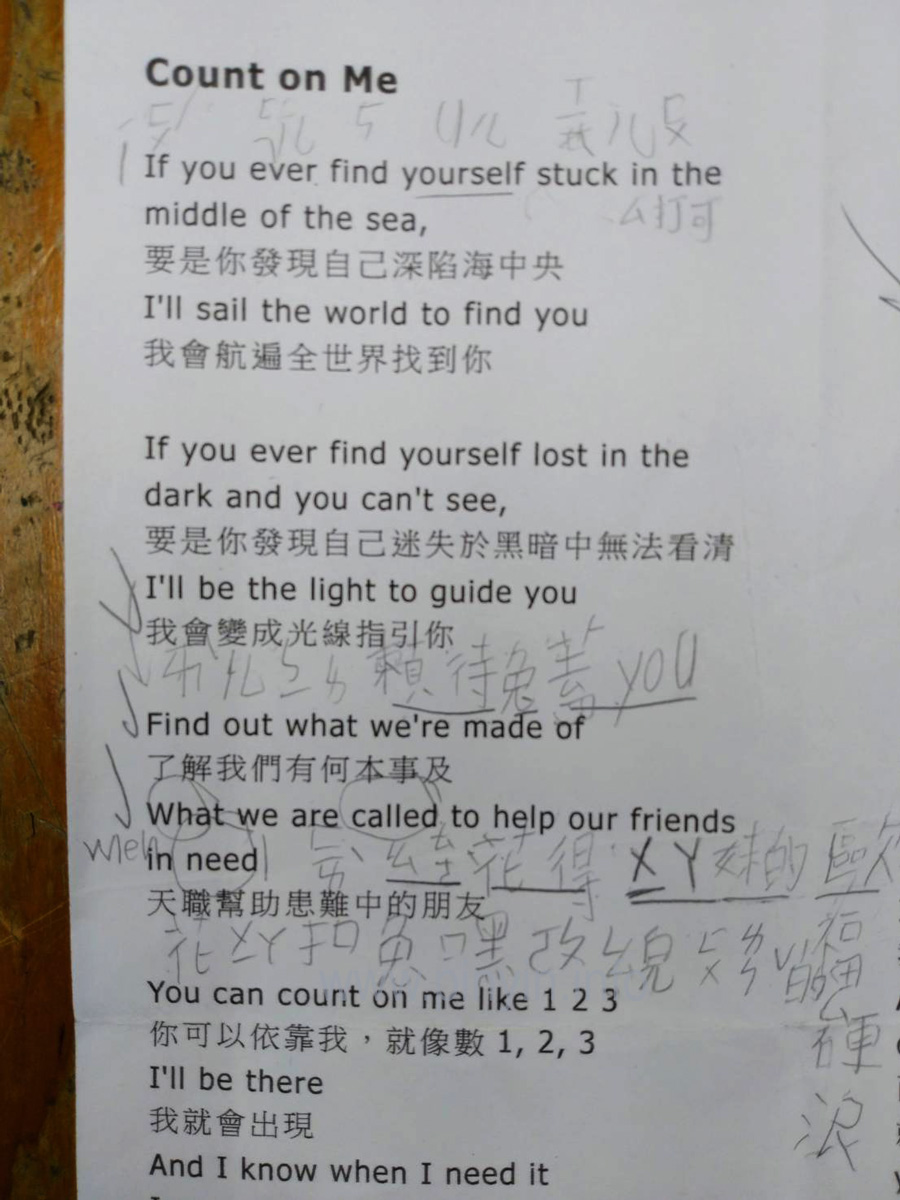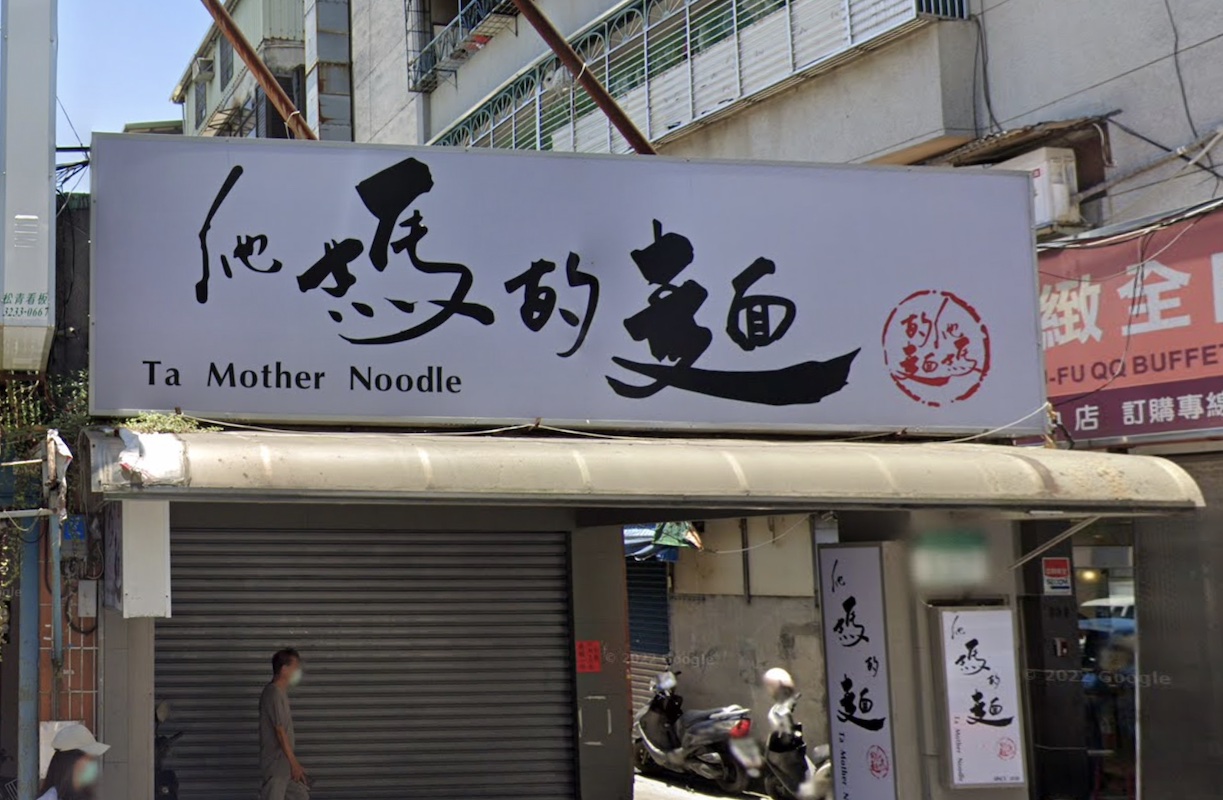Archive for Romanization
Mandarin phonetic annotation for English
The PRC uses hànyǔ pīnyīn 汉语拼音 ("Sinitic spelling") for phonetic annotation, Taiwan uses zhùyīn fúhào 注音符號 ("phonetic symbols") for the same purpose. Since we are well acquainted with pīnyīn, but not very familiar with zhùyīn fúhào, I will focus on the latter in this post:
Mark Swofford, "If you ever find yourself stuck on how to pronounce English", Pinyin News (5/7/23):
Here are some lyrics from a popular song, “Count on Me,” by Bruno Mars, with a Mandarin translation. The interesting part is that a Taiwanese third-grader has penciled in some phonetic guides for him or herself, using a combination of zhuyin fuhao (aka bopo mofo) (sometimes with tone marks!), English (as a gloss for English! and English pronunciation of some letters and numbers), and Chinese characters (albeit not always correctly written Chinese characters — not that I could do any better myself). Again, this is a Taiwanese third-grader and so is someone unlikely to know Hanyu Pinyin.
Read the rest of this entry »
German linguist Möllendorff and the earliest recordings of Chinese
"UCSB Library Acquires Rare Chinese Language Audio Cylinder Recordings", UCSB Library Newsletter (September, 2024)
The UC Santa Barbara Library is excited to announce the recent acquisition of the Paul Georg von Möllendorff Chinese Cylinders, a collection of wax cylinders widely considered to be the first audio recordings from China. The cylinders, recorded in the late 1800s by linguist Möllendorff, contain sixteen recitations of a popular, celebrated poem "Returning Home"' by Tao Yuanming. Möllendorff recorded the poem in various Chinese dialects to document the differences in regional languages at the time. Today, the cylinders provide a rare glimpse into the history of Chinese language and include dialects that are considered critically endangered or extinct.
Read the rest of this entry »
Taiwanese romanization and subtitles
Song by a Taiwanese band with sinographic and romanized transcriptions of the lyrics in the center and Mandarin translation at the bottom as subtitles, via Bilibili:
Read the rest of this entry »
Mixed script writing in Taiwan
[This is a guest post by Kirinputra]
Read the rest of this entry »
Perso-Arabic script for Mandarin, Pe̍h-ōe-jī for Taiwanese: sad cripples?
We have been intrigued by Iskander Ding since encountering him on X/Twitter a while back, several posts from his account having made it onto Language Log (see "Selected readings").
With a handle like his, where Iskandar is the Persian form of the name of the Macedonian king Alexander the Great (256–323 BC) and Ding has an unmistakable Sinitic / Hannic ring to it, we suspected from the start that he is a Hui (Chinese Muslim). So far, though, we have not been able to track down the sinographs for his full Hannic name, which is a bit unusual, where even Mongols, Uyghurs, Tibetans, and other non-Sinitic people are compelled to take Sinographic names.
Iskandar Ding is currently writing a Ph.D. dissertation on Yaghnobi linguistics and culture at SOAS in London (see this page for basic information about him).
Yaghnobi is an Eastern Iranian language spoken in the upper valley of the Yaghnob River in the Zarafshan area of Tajikistan by the Yaghnobi people. It is considered to be a direct descendant of Sogdian and has sometimes been called Neo-Sogdian in academic literature.
(source)
Here is a 53 second video of ID announcing a talk on Perso-Arabic-script Hannic.
Here is the 43.44 talk ("Xiao’erjing – Writing Chinese with Perso-Arabic Letters" – Iskandar Ding | PG 2022) as it actually happened. IA comment: "What he said throughout the talk was pleasing now and then — saying 'Eastern Turkistan' in Uighur for example…".
Here is a 1 hour 22 minute interview with ID. If you click the link it will open at the 18:11 mark, where he speaks of Perso-Arabic-script Hannic . That part ends at 22:40.
The above is based largely on information provided by IA, and the following quotes IA directly:
Read the rest of this entry »
Pinyin resurgent
Hopefully.
Some exciting news.
A member of the PRC's National Committee of the Chinese People's Political Consultative Conference (the yearly meeting of which is taking place in Beijing right now) is urging schools to increase the time spent teaching Pinyin (currently 4-6 weeks) to a semester or even longer to help ensure more students have a solid foundation in this skill. Intriguingly, there's also a mention of using more "texts."
Here's an account of what's happening:
"Schools should spend more time teaching Pinyin: PRC politician", Pinyin News (3/7/24)
Xu Xudong (徐旭東/徐旭东), a member of the Chinese People’s Political Consultative Conference and a professor at Central China Normal University in Wuhan, is advocating that public schools in China allocate substantially more time to the teaching of Hanyu Pinyin.
Read the rest of this entry »
Major romanization change coming in Japan
From Pinyin News (3/4/24):
"Japan to switch official romanization from Kunrei-shiki to Hepburn"
Japanese newspapers are reporting that Japan will officially switch from Kunrei-shiki romanization to Hepburn romanization.
In a front-page column last week, the Asahi Shimbun said, “A draft report recently published by the Council of Cultural Affairs pointed out that the Hepburn system is more widely used than the Kunrei system, and it is expected that the notation will be adjusted to reflect this. It is surprising because the writing system has not changed for about 70 years, but if confusion can be avoided, the change is to be welcomed.”
Read the rest of this entry »
What is the difference between a dragon and a /lʊŋ³⁵/?
Today is the Lunar New Year's Day, and it's the Year of the Dragon / /lʊŋ³⁵/ . As such, a kerfuffle is stirring in China and the English-speaking world regarding the English translation of lóng ⿓ / 龙 / 竜 (J), which is usually "dragon".
I will begin with the pronunciation of the word. In MSM, it is lóng (Hanyu Pinyin), lung2 (Wade-Giles), lúng (Yale), long (Gwoyeu Romatzyh [the configuration of GR tonal spelling for this syllable indicates second tone), лун (Palladius). They all represent the same MSM syllable. I will not list the scores of other topolectal pronunciations for Cantonese, Shanghainese, Hakka, Hokkien, Xiamen / Amoy, Sichuan, etc., etc. and their dialects and subdialects.
Read the rest of this entry »
Butter chicken
Who owns it?
It's sort of like who owns kimchee, Koreans (of course!) or Chinese — we've been through that many times — except that the question of who has the rights to claim they invented butter chicken is ostensibly internecine / intranational rather than international (but maybe not [see below]), as is the case with kimchee.
"India’s courts to rule on who invented butter chicken: Two Delhi restaurants both claim to have the right to call themselves the home of the original butter chicken recipe" by Hannah Ellis-Petersen, The Guardian (1/25/24)
Judging from the account in The Guardian, the squabbling between the two Delhi restaurants is both picayune and misplaced:
Read the rest of this entry »
Pinyin vs. English
I knew that in the future it would come to this. More than forty years ago, I predicted that one day China would have to make a choice between Hanyu Pinyin and English when it comes to phonetic writing. As we say in Mandarin, "guǒrán 果然" ("as expected / it turns out")….
It seems that there's been quite a flap over the replacement of signs for subway station stops from English to Hanyu Pinyin, as documented (verbally and visually [many photographs]) in this Chinese article. Naturally, the Chinese characters are there in either case, but what people are complaining about is the replacement of English with Hanyu Pinyin. For example, changing "Library" to "Tushuguan" or "Hefei Train Station" to "Hefei Huochezhan".
Read the rest of this entry »
Greater China Co-Prosperity Sushi and Ramen Kitchen
Shouldn’t that be Zhonghua Pan-Asian Kitchen Ramen Wok Premium Sushi? pic.twitter.com/tTUaWidjL3
— James Millward 米華健 (@JimMillward) June 4, 2023
Read the rest of this entry »

